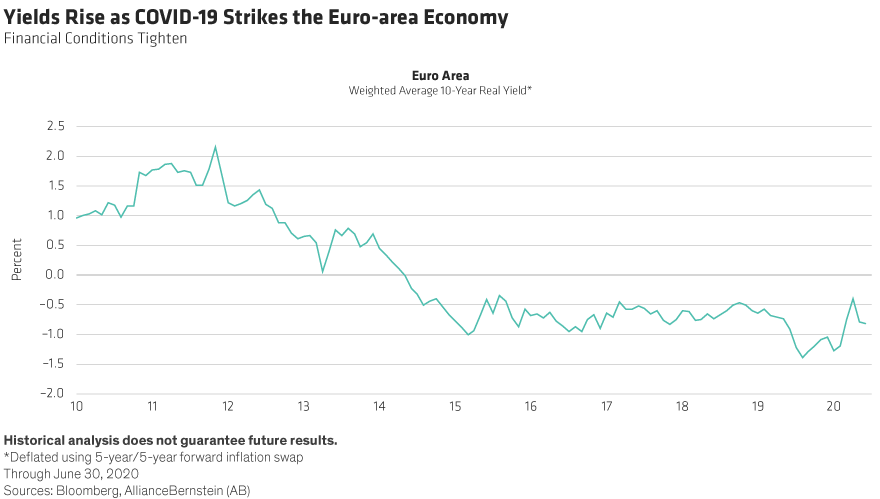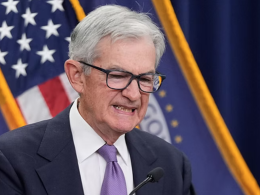by Darren Williams, AllianceBernstein
COVID-19 is catapulting the world into a new era of central banking—helping governments finance growing debt by capping bond yields near zero. Despite some hurdles, we’re confident that this will play out just as powerfully in the euro area as elsewhere. That’s why we remain constructive on peripheral euro-area bond markets.
“Joined at the Hip” Works in Europe Too
In this new era, monetary and fiscal policy are closely coordinated—“joined at the hip.” But the complex way the EU is structured can create obstacles to this coordination. Indeed, some investors fear that Germany’s deep aversion to monetary financing will prevent the European Central Bank (ECB) from keeping a lid on bond yields.
Those fears seemed to be realized on May 5, when the German Federal Constitutional Court (GFCC) ruled that the European Central Bank (ECB) might have exceeded its mandate with the implementation of its Public Sector Purchase Programme (PSPP).
The GFCC ruling is an important reminder that many of the ECB’s actions remain controversial in Germany. It also highlights the tensions at the heart of the European Union (EU), particularly the separation of powers between the EU and its member states.
But it’s most unlikely to impair the ECB’s willingness or ability to keep bond yields low. The European Court of Justice (ECJ)—not the GFCC—has jurisdiction over the ECB and has already ruled that the PSPP is legal. That’s why the GFCC’s ruling did not prevent the ECB from increasing its asset purchase program by an additional €600 billion on June 4.
The GFCC ruling has had some impact though. During the press conference on June 4, President Lagarde was quick to emphasize that the ECB’s actions were “proportionate” to its aims and that the Governing Council had carefully weighed the costs and benefits before reaching its decision.
The ruling is also forcing the ECB to justify its actions more clearly in terms of its price stability mandate. In a blog on June 5, Chief Economist Philip Lane noted the importance of the weighted-average bond yield in the euro area. Largely due to higher peripheral yields, this measure rose sharply in March and April, leading to tighter financial conditions (Display) when easing was urgently needed.

Linking the weighted-average bond yield to the inflation target is a powerful way for the ECB to justify its bond purchases and its willingness to hold down peripheral bond yields. So much so that it could be a way for the ECB to introduce more explicit yield-curve control in the euro area.
“Whatever It Takes” Commitment Lives On
Ever since Mario Draghi promised to do “whatever it takes to preserve the euro,” the ECB’s willingness to underwrite the sovereignty of all euro-area countries has dominated the outlook for Europe’s fixed-income markets. Despite signs of progress on a European Recovery Fund, it continues to do so today.
The good news is that the ECB’s commitment is as strong today as it was eight years ago. This dual mandate will only face strain when low yields conflict with the inflation target itself. With the ECB’s latest forecasts putting core inflation at just 0.9% in 2022—making a case for even more stimulus later in the year—that’s a very distant prospect.
European Sovereign Bonds Are Still Attractive
At a time when central banks are anchoring yields close to the policy rate and reducing volatility—thus suppressing the return potential from holding sovereign bonds—the ECB’s willingness to stand behind peripheral bond markets continues to make a positive case for European fixed-income markets.
With the ECB transitioning from anchoring German bond yields to reducing the weighted-average euro-area yield by compressing sovereign spreads, government yield curves in Europe are steeper and offer higher hedged yields than in most other developed markets. In a world of lower volatility, those attributes make European sovereign bonds very attractive for global investors.
Our highest conviction is in government bonds with maturities of 10 years or less. That’s because the power of the ECB’s key policy tools—a negative deposit rate and quantitative easing—starts to fade at longer durations, especially when the market is expecting much heavier bond supply. That supply is likely to create upward pressure on longer maturities and keep longer-dated yield curves steeper.
With global bond yields and volatility close to record lows, the best period for government bond returns is probably behind us. But there are still opportunities for active investors, including the relatively high yields still available in the euro-area periphery—and especially in the new era of yield caps and yield-curve control.
Darren Williams is Director—Global Economic Research at AllianceBernstein.
John Taylor is Co-Head of European Fixed Income and Director of Global Multi-Sector at AllianceBernstein.
The views expressed herein do not constitute research, investment advice or trade recommendations and do not necessarily represent the views of all AB portfolio-management teams and are subject to revision over time. AllianceBernstein Limited is authorized and regulated by the Financial Conduct Authority in the United Kingdom.
This post was first published at the official blog of AllianceBernstein..













